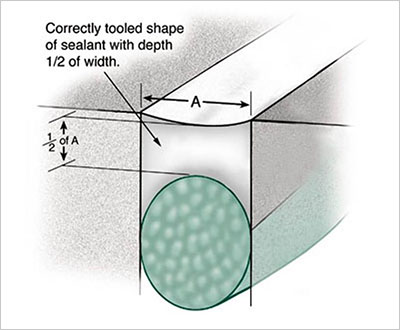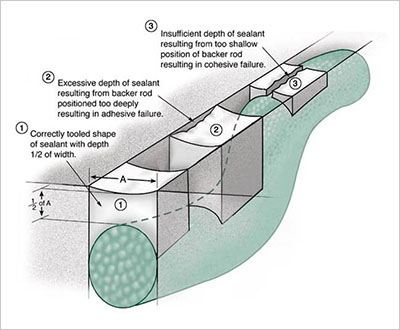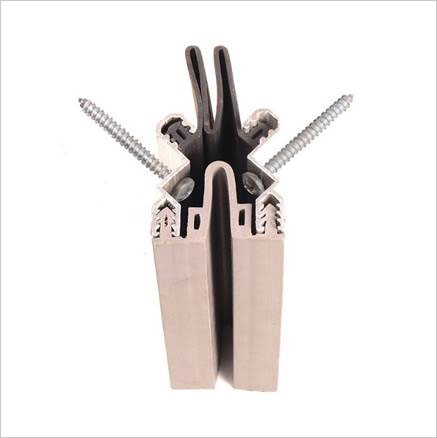Introduction to joints in Buildings and Civil Engineering Structures
There are three basic types of joints involved in almost all buildings and civil engineering structures:
Construction joints – typically the daywork joints in concrete, where one pour or day’s work ends and another begins, which are normally bonded together with mechanical dowels and/or compounds and which have no future movement requirements. Additional joint sealing is not normally required.
Connection joints, also known as isolation joints – these are usually at any interface between dissimilar materials or units, such as the gaps around window and door frames. These are normally filled with preformed or expanding foams, hidden by cover plates and sealed with simple trowelled or extruded elastic or flexible sealing compounds.

Major new building developments such as Canary Wharf rely on secure joint sealing systems from Emseal
Movement joints – typically a movement joint, also known as an expansion joint because their key function is to allow the building components on either side expand, whilst the joint effectively shrinks, is a gap in a structure or structural element which is designed to separate its constituent parts and to accommodate movement of a defined nature and amount. The bigger and more complex the structure, the bigger and more complex can be the movement joints, and the bigger the challenges are in successfully accommodating the movement and simultaneously sealing them.
Joint Standards for Construction
Movement and expansion joint design and sealing standards - around the world include multiple national and international standards that relate to the dimensioning of construction, connection and movement joints in different building materials. These include design standards that help to calculate the requirements and necessary locations for movement joints in and between different building materials, which in the UK and elsewhere, can still include reference to the well known BS 6093:1993/ 2006 Design of joints and jointing in building construction - Guide (+A1 update added 2013), together with the updates as relevant Eurocodes. In North America this guidance is given in a series of ASTM Standards and Guides, including C1193 and C1472, plus the older ‘Expansion Joints in Buildings’, Technical Report No. 65 (1974), which is also still commonly referred to in that part of the world.
Joint Sealing Systems and Joint Sealants Joint sealing system, such as the sealing compounds designed for gun extrusion to seal construction, isolation and smaller expansion movement joints are sometimes referred to collectively as ‘mastic’ sealants, although surprisingly, there has never been a specific ‘mastic’ sealant material as such. The traditional mastic sealants first introduced in the UK and the US were predominately based on linseed and other plant oils or bitumen-based compounds that acted as flexible (although not with elastic recovery) fillers and earliest types of joint sealers. Butyl rubber polymers and then the first acrylic resin based joint sealants were produced in the mid-20th Century, which themselves were quite quickly, but gradually replaced with more modern polymer technologies. Today the vast majority of joint sealing compounds are acrylic, silicone, polyurethane, or hybrids and combinations of these polymer resin based. As a result, there are now many types of movement joint sealing compounds and also there has been simultaneous development of preformed joint sealing strips and profiles.

Correctly Applied Extruded Joint Sealant

Issues with Incorrectly Applied Extruded Joint Sealants

Typical Strip Joint Sealant (with Mechanical Fixings)
The potential joint sealing solutions available today, therefore ranges from simple extruded, gun-applied joint sealants, to factory produced, preformed movement joint profiles and other bespoke joint sealing systems. The selection of the most suitable solution for any given joint is generally dependent on the joint size, the joint movement capability and any other joint performance and exposure requirements, This is obviously in addition to the structural design onsiderations and the practical installation possibilities on site, including access to do this, and the overall complexity of the selected sealing solution.
Movement joint sealing system performance In addition to the potential expansion, the movement joint sealing requirements will generally also include one or more of the following additional demands e.g. for watertightness; fire resistance; thermal insulation; acoustic insulation; impact and abrasion resistance (e.g. footfall / vehicular traffic, plus wear and tear on the surface); UV light resistance, or chemical resistance. There could also be other project-specific requirements. For example, if a horizontal joint is to be fitted into the top deck of a multi-storey car park, these additional performance requirements might well include for traffic and abrasion resistance; frost and freeze/thaw resistance (including resistance to de-icing salts), and for the joint sealing system to be chemically resistant to oils and other automotive fluids. In some situations, fire resistance and thermal or acoustic insulation values might also need to be considered, depending on whatever occupies the floor levels immediately below, adjacent to, or above the parking decks concerned.
The risks and the costs of claims being brought against a building /facility owner for liabilities brought about by failings in the movement joints design and/or sealing systems should not be underestimated. It is therefore essential to avoid expansion joint problems, such as those due to inadequate joint design, inadequate joint sealing system installations, or the use of joint sealing materials or systems with inadequate service-life or durability. As discussed on the "Everything is Bigger in America" Page of this website, the costs of not doing so can be huge for everybody involved in the project, if the joints are not correctly designed and securely sealed with an appropriate joint sealing system solution.
